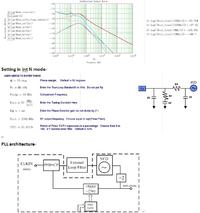wyhgod
Newbie level 4
Dear all,
I have designed a fractional N synthesizer,and multi-modulus N range is from 64-255.Using 20 bit sigma-delta to implement fractional mode.
Power supply for multi-modulus N and sigma-delta are bonding to pad seperately,and are 3.3v.
when i test close loop phase noise, i find the phase noise in int N mode is better than frac N mode about 10dB(@10khz,@100khz),both modes use the same N.
In frac mode,when i reduce power supply voltage for multi-modulus N to 2.2V ,the phase noise is better about 5db than 3.3v power supply for multi-modulus.
Also in frac mode, if i reduce power supply voltage for sigma-delta, there is no change for phase noise.
first question,why is there 10dB phase noise difference between INT N mode and frac N mode.
second question,why the pahse noise is better if i reduce power supply voltage for multi-modulus N.
Can anybody tell me why?
Best Regards
devin
I have designed a fractional N synthesizer,and multi-modulus N range is from 64-255.Using 20 bit sigma-delta to implement fractional mode.
Power supply for multi-modulus N and sigma-delta are bonding to pad seperately,and are 3.3v.
when i test close loop phase noise, i find the phase noise in int N mode is better than frac N mode about 10dB(@10khz,@100khz),both modes use the same N.
In frac mode,when i reduce power supply voltage for multi-modulus N to 2.2V ,the phase noise is better about 5db than 3.3v power supply for multi-modulus.
Also in frac mode, if i reduce power supply voltage for sigma-delta, there is no change for phase noise.
first question,why is there 10dB phase noise difference between INT N mode and frac N mode.
second question,why the pahse noise is better if i reduce power supply voltage for multi-modulus N.
Can anybody tell me why?
Best Regards
devin
